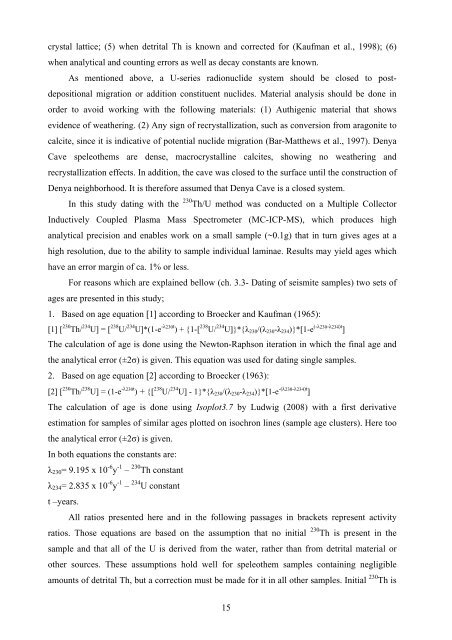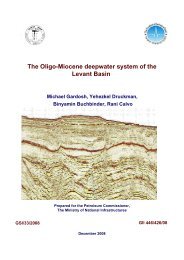tivity on the carmel faul
tivity on the carmel faul
tivity on the carmel faul
Create successful ePaper yourself
Turn your PDF publications into a flip-book with our unique Google optimized e-Paper software.
crystal lattice; (5) when detrital Th is known and corrected for (Kaufman et al., 1998); (6)<br />
when analytical and counting errors as well as decay c<strong>on</strong>stants are known.<br />
As menti<strong>on</strong>ed above, a U-series radi<strong>on</strong>uclide system should be closed to postdepositi<strong>on</strong>al<br />
migrati<strong>on</strong> or additi<strong>on</strong> c<strong>on</strong>stituent nuclides. Material analysis should be d<strong>on</strong>e in<br />
order to avoid working with <strong>the</strong> following materials: (1) Authigenic material that shows<br />
evidence of wea<strong>the</strong>ring. (2) Any sign of recrystallizati<strong>on</strong>, such as c<strong>on</strong>versi<strong>on</strong> from arag<strong>on</strong>ite to<br />
calcite, since it is indicative of potential nuclide migrati<strong>on</strong> (Bar-Mat<strong>the</strong>ws et al., 1997). Denya<br />
Cave speleo<strong>the</strong>ms are dense, macrocrystalline calcites, showing no wea<strong>the</strong>ring and<br />
recrystallizati<strong>on</strong> effects. In additi<strong>on</strong>, <strong>the</strong> cave was closed to <strong>the</strong> surface until <strong>the</strong> c<strong>on</strong>structi<strong>on</strong> of<br />
Denya neighborhood. It is <strong>the</strong>refore assumed that Denya Cave is a closed system.<br />
In this study dating with <strong>the</strong> 230 Th/U method was c<strong>on</strong>ducted <strong>on</strong> a Multiple Collector<br />
Inductively Coupled Plasma Mass Spectrometer (MC-ICP-MS), which produces high<br />
analytical precisi<strong>on</strong> and enables work <strong>on</strong> a small sample (~0.1g) that in turn gives ages at a<br />
high resoluti<strong>on</strong>, due to <strong>the</strong> ability to sample individual laminae. Results may yield ages which<br />
have an error margin of ca. 1% or less.<br />
For reas<strong>on</strong>s which are explained bellow (ch. 3.3- Dating of seismite samples) two sets of<br />
ages are presented in this study;<br />
1. Based <strong>on</strong> age equati<strong>on</strong> [1] according to Broecker and Kaufman (1965):<br />
[1] [ 230 Th/ 234 U] = [ 238 U/ 234 U]*(1-e -λ230t ) + {1-[ 238 U/ 234 U]}*{λ 230 /(λ 230 -λ 234 )}*[1-e (-λ230-λ234)t ]<br />
The calculati<strong>on</strong> of age is d<strong>on</strong>e using <strong>the</strong> Newt<strong>on</strong>-Raphs<strong>on</strong> iterati<strong>on</strong> in which <strong>the</strong> final age and<br />
<strong>the</strong> analytical error (±2σ) is given. This equati<strong>on</strong> was used for dating single samples.<br />
2. Based <strong>on</strong> age equati<strong>on</strong> [2] according to Broecker (1963):<br />
[2] [ 230 Th/ 238 U] = (1-e -λ230t ) + {[ 238 U/ 234 U] - 1}*{λ 230 /(λ 230 -λ 234 )}*[1-e -(λ230-λ234)t ]<br />
The calculati<strong>on</strong> of age is d<strong>on</strong>e using Isoplot3.7 by Ludwig (2008) with a first derivative<br />
estimati<strong>on</strong> for samples of similar ages plotted <strong>on</strong> isochr<strong>on</strong> lines (sample age clusters). Here too<br />
<strong>the</strong> analytical error (±2σ) is given.<br />
In both equati<strong>on</strong>s <strong>the</strong> c<strong>on</strong>stants are:<br />
λ 230 = 9.195 x 10 -6 y -1 – 230 Th c<strong>on</strong>stant<br />
λ 234 = 2.835 x 10 -6 y -1 – 234 U c<strong>on</strong>stant<br />
t –years.<br />
All ratios presented here and in <strong>the</strong> following passages in brackets represent ac<str<strong>on</strong>g>tivity</str<strong>on</strong>g><br />
ratios. Those equati<strong>on</strong>s are based <strong>on</strong> <strong>the</strong> assumpti<strong>on</strong> that no initial 230 Th is present in <strong>the</strong><br />
sample and that all of <strong>the</strong> U is derived from <strong>the</strong> water, ra<strong>the</strong>r than from detrital material or<br />
o<strong>the</strong>r sources. These assumpti<strong>on</strong>s hold well for speleo<strong>the</strong>m samples c<strong>on</strong>taining negligible<br />
amounts of detrital Th, but a correcti<strong>on</strong> must be made for it in all o<strong>the</strong>r samples. Initial 230 Th is<br />
15

















